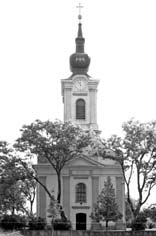According to written sources from 1758, the administrator of the Timisoara diocese Arsenije Radivojević states that the church in Tisa St. Miklos (now Ostojićevo) existed already that year, and that it was erected even earlier and that it was dedicated to St. Never. Namely, he states that on November 1, 1733, the Temišvar bishop Nikolai Dimitrijevic revenged the antimins for that church. The church was built of cherries and “white-colored”, without towers, and was covered with rush. Considering the dearth of building material, it seems that a larger deal was carried out on the church in 1781, since from that time the list of Serbs was kept, indicating what would be given when “the church starts”.
The original church was located east of the church today, which was erected between 1818 and 1822. In 1834, 19 forints and 10 cutters “for the borders of the old throne” were used in its place due to the deterioration due to worsening, when the new church was served for several years. This memorial-cross at the place of the altar of the old Serbian Orthodox Church in Ostojićeva still exists today and testifies about the first Serbian sanctuary in the city.
From the church archive we learn that for the construction of the new church it was necessary to provide 17,500 forints from which the church municipalities have already collected 10,000 forints. After securing the entire amount (other revenues are secured by cash on “surplus”, from testamentary and other promises, the sale of candles, etc.), the church municipality has been granted approval for the construction of the church from the conservatory of the Timisoara eparchy. A contract was signed with Friedrich Schwerck, the Szeged mill, about the commencement of works. According to the contract, Svverc undertook to obtain the necessary material for that amount. The setting of the “fundament” on October 17, 1818 was attended by district protopresviter Jovan Jovanovic.
Most of the most necessary jobs were done sometime in the first days of September 1822, and the iconostasis from the old church was transferred to it to serve the new one. From that first iconostasis, the imperial doors, the painting work of Teodor Ilić Češljar, have been preserved to this day. The refreshment of the church was done by Jovan Jovanovic on February 4, 1823, and the rest of the work on the church was done after the refreshment.
The church is basically a one-nave building with a polygonal apse and singers in the east, and a facade in the west above which the bell tower rises. When the church municipality collected an enormous amount of funds in 1847, it was possible to hire the already famous brothers of Mihailo and Lazar Janic from Arad for woodworking works on the iconostasis, for icon frames, work with singers, etc. In the period from 1847 to 1856, as we learn from the books of the account, brothers Janić performed all the woodworking works in the church. The church municipality signed a contract with Nikola Aleksic on February 18, 1868 for painting and golden iconostasis, as well as painting the walls and vaults in the church. Nikola Aleksić painted the church for about three years, and the main part of the work ended in 1871, which is confirmed by an inscription in the middle of the partition wall of the choir.His son Dusan finished after his father’s death the remaining unfinished painting work by the end of 1873.
Gilding of the entire woodcut of the iconostasis was done by Karl Lisi, a goldsmith from Kikinda, while Edvard Fihtner, a painter from Vienna, performed the marbling of tables, another woodwork, and gilded a minor part of the sanctified objects.
Carvings and painting work were done in the style of classicism, and the icons were made with oil technique on a wooden surface.
SERBIAN ORTHODOX CHURCH OF ST. NICHOLAS


0 comments on “SERBIAN ORTHODOX CHURCH OF ST. NICHOLAS”